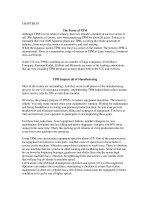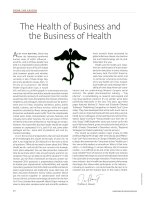Tài liệu The Power Of Gaps(pdf) ppt
Bạn đang xem bản rút gọn của tài liệu. Xem và tải ngay bản đầy đủ của tài liệu tại đây (171.65 KB, 3 trang )
The Power Of Gaps
By Goran Yordanoff
Have you ever noticed a stock or an index
, which seemed to be moving
effortlessly in its desired direction, suddenly stop dead in its tracks? Have you
ever noticed how this often happens nowhere near a major moving average or
trend line? Do you sometimes find yourself watching a trade reverse in your face
and not have an explanation as to why this happens?
More often than not, the answer can be found by identifying areas of gaps on
weekly, daily and intraday charts. In order to determine all potential areas of
support and resistance when you are evaluating a trade (we all have our targets
and stops in mind before we enter the trade, right? Right?) you must always
consider gap areas.
For clarification, the Japanese refer to a gap as a "window." Most of my charting
analysis is based on Japanese candlestick charting theory which was primarily
brought to prominence in the United States by Steve Nison. Nison is considered
to be the "Godfather" of Japanese candlestick analysis in the United States.
While Japanese candlestick analysis has really only been practiced for the past
25 years in the United States (thanks to Steve Nison's research and work), the
Far East has been utilizing these principles and theories for centuries.
There is a Japanese saying, "A clever hawk hides its claws." For those of us who
utilize candlesticks, we believe "the claws" of the market to be hidden within their
message (from Nison, Beyond Candlesticks). Let us consider the case of Merck
and Co. (MRK). In my Dec. 27, 2000, commentary, I pointed out the potential of
Merck and Co. to fall out of its consolidation range due to negative divergences
with its technicals. I pointed out potential target areas based on two windows
which were formed on gaps up in October, 2000. Let's go back and examine the
chart from Dec. 27:
Now let's take a look at MRK's present day chart and summarize what actually
transpired subsequent to my Dec. 27 commentary.
As we can clearly see, MRK fell violently out of its trading range in early January,
2001. We can see a multiple-day effort to stabilize at the area of gap #1 (as
shown on chart). However, this gap #1 zone was violated and the zone of gap #2
was quickly tested. To date, the zone of gap #2 has halted a further decline in the
share price of MRK.
However, it is not certain as to whether or not MRK can resume its prior uptrend
at this time. This is due to the prior support zone of gap #1 now serving as
resistance during rally attempts. Until this new resistance zone of gap #1 can be
overcome, MRK appears to be locked in a trading range between its new
resistance area of gap #1 and its support zone of gap #2. A break through either
one of these zones would suggest continuation in that direction.
Most who were observing the recent trading activity of Merck and Co. may have
been perplexed by its trading pattern as it seemed to act in total disregard for
major moving averages and trendlines. The key to having made a profitable trade
in this particular instance was identifying where the market was "hiding its claws."
The "claws," as we have proven here, were hidden within the gap areas
described above.
Copyright © 2001 by TradingMarkets.com, Inc.









